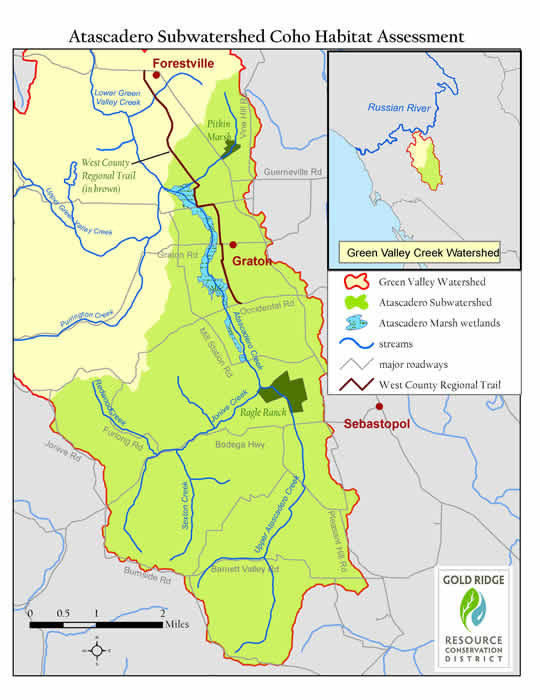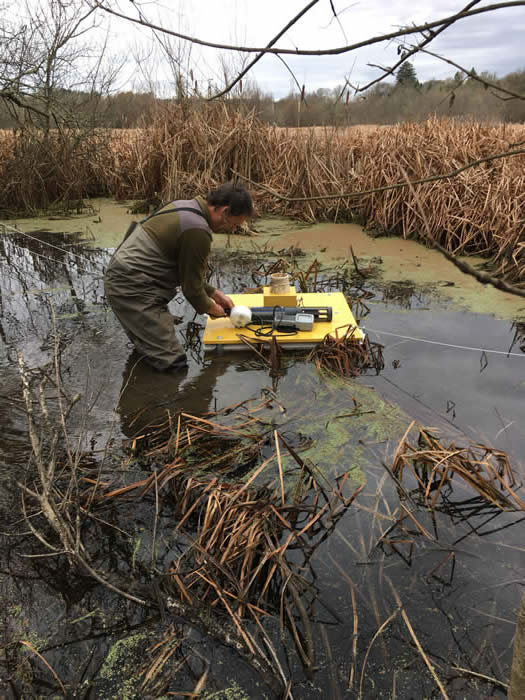Atascadero Creek Subwatershed Habitat Study
The Atascadero Subwatershed Coho Habitat Assessment (ASCHA) Summary Report represents the first phase in a multi-project effort to address limiting factors to aquatic habitat health and salmonid passage in the Atascadero Creek Subwatershed (tributary to Green Valley Creek). With enormous gratitude to landowners along Atascadero Creek and its tributaries who have granted us access to survey habitat conditions for coho salmon, we’re excited to share the Atascadero Subwatershed Chapter of the Green Valley Creek Watershed Management Plan. The ASCHA report summarizes the results of habitat and water quality study that Gold Ridge RCD and several of our project partners, O’Connor Environmental, Inc., California Department of Fish & Wildlife, and California Sea Grant, have been working on since 2018, and the restoration and enhancement recommendations that we have planned for the near future.
See the Atascadero Subwatershed Coho Habitat Assessment Summary Report here.
See the Green Valley Creek Watershed Management Plan here.
Landowner Participation
Thank you to the landowners who assisted in this study. We appreciate your partnership in allowing us access to the creek where it runs through your property. We could not have accomplished this study without it.
Public Meetings
View recordings of past public meetings here:
The project team hosted a virtual public meeting on December 14, 2021 over Zoom to present on the team's efforts in the Atascadero watershed. View the 12/14/21 meeting recording here >>
It features a series of presentations by staff from the Gold Ridge Resource Conservation District, O’Connor Environmental, Inc., California Sea Grant, Baseline Consulting, and the California Department of Fish & Wildlife on efforts underway to study and enhance habitat in the Atascadero watershed. This project was funded by the California Department of Fish & Wildlife through the Watershed Restoration Grant Program. Presentation slides from the 12/14/21 meeting can be found here >>
Our first public meeting about this study was held on November 6, 2019 at Apple Blossom Elementary School. See the presentations from the 11/6/19 meeting here >>
Atascadero Creek is part of the Russian River watershed. It flows north from Sebastopol to Forestville where it meets with Green Valley Creek, then Green Valley Creek flows to the Russian River. It neighbors the Laguna de Santa Rosa watershed, but is not connected. Atascadero Creek has four major streams that drain into it: Redwood Creek, Jonive Creek, Sexton Creek and Pitkin (also called Sullivan) Creek. See the subwatershed map at right. From the modest information we have about the watershed, we know that Atascadero Creek watershed is a complex and diverse system. In parts (particularly the upper reaches) the waterways are creek-like with defined channels and year-round flow, fed by rainfall and springs. In other parts (particularly in the lower reaches), the waterways become dense and marsh-like with less defined creek channels and at times no water flowing on the surface.
The stream that Atascadero flows into, Green Valley Creek, has been identified as critical and restorable habitat for the endangered Central California Coast coho salmon, and it regularly supports the Russian’s most robust wild coho population. Despite anecdotal evidence of coho being historically present, they haven’t been observed in recent surveys. Local landowners have memories of finding coho back in the old days, and historians hold that the creek has been used by coho in the past. In the winters of 2017 and 2018, federal partners in conservation released juvenile coho salmon to the upper reaches of the creek in the hopes that the fish would survive and establish a viable population in the stream.
Community Engagement
This project required broad engagement of local landowners to be a success. We reached out to the community through multiple avenues:
- -Mailers: Landowners located along the Atascadero Creek and its tributaries received a letter with the Landowner Access Agreement request in March 2019
- -Public meetings: Public meetings were held to present on the project, answer questions and engage landowners in the study
- -Social Media: Neighbors had the opportunity to discuss the project on Nextdoor and Facebook
- -E-news: Participating and interested landowners were kept informed of project news via e-news communications
Ready to participate?
If you are a landowner located on the Atascadero Creek or its tributaries (see map at top right) and you are ready to participate in the study, review the Landowner Access Agreement and submit the form to the Gold Ridge RCD.
Contact
Sierra Cantor
Ecologist, Gold Ridge Resource Conservation District
(707) 823-5244 | [email protected]
Gold Ridge Resource Conservation District
2776 Sullivan Road, Sebastopol, CA 95472
(707) 823-5244 | www.GoldRidgeRCD.org

